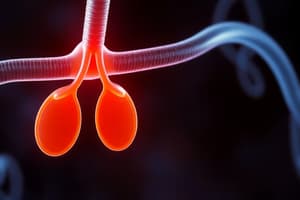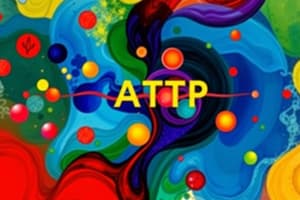Podcast
Questions and Answers
What is the principal pigment responsible for photosynthesis?
What is the principal pigment responsible for photosynthesis?
- Chlorophyll-b
- Chlorophyll (correct)
- Carotene
- Chlorophyll-a
Chlorophyll absorbs all colors of the visible spectrum equally.
Chlorophyll absorbs all colors of the visible spectrum equally.
False (B)
Name the two main kinds of chlorophyll.
Name the two main kinds of chlorophyll.
Chlorophyll-a and Chlorophyll-b
The visible colors of the spectrum include red, orange, yellow, green, blue, indigo, and ____.
The visible colors of the spectrum include red, orange, yellow, green, blue, indigo, and ____.
Match the types of chlorophyll with their respective colors:
Match the types of chlorophyll with their respective colors:
Which of the following correctly describes ATP?
Which of the following correctly describes ATP?
Photosynthesis converts glucose and oxygen into carbon dioxide and water.
Photosynthesis converts glucose and oxygen into carbon dioxide and water.
What are the three components that make up the structure of ATP?
What are the three components that make up the structure of ATP?
The process of plants using sunlight to convert water and carbon dioxide into glucose is called __________.
The process of plants using sunlight to convert water and carbon dioxide into glucose is called __________.
Match the processes with their descriptions:
Match the processes with their descriptions:
Flashcards are hidden until you start studying
Study Notes
Energy Storage in Cells
- Energy in living cells is stored in chemical compounds.
- Principal energy storage compounds include:
- ATP (Adenosine Triphosphate): energy-rich, akin to a charged battery.
- ADP (Adenosine Diphosphate): energy-poor, comparable to a dead battery.
Structure of ATP
- Composed of:
- Adenine: a nitrogen base.
- Ribose: a five-carbon sugar.
- Chain of three phosphate groups.
Conversion of ADP to ATP
- ADP has two phosphate groups; ATP has three.
- Energy availability allows a phosphate group to be added to ADP, converting it to ATP.
- The addition of the third phosphate stores energy.
- Energy is released when the third phosphate is removed from ATP.
- ATP powers various cellular processes like:
- Photosynthesis
- Protein synthesis
- Muscle contraction
- Active transport across cell membranes.
- ATP is crucial as the basic energy source for all living cells.
- Muscle cells regenerate approximately 10 million ATP molecules per second.
Photosynthesis Overview
- Plants convert sunlight, water, and carbon dioxide into high-energy sugars (glucose).
- Oxygen is a byproduct of the process.
- Photosynthesis is essential for providing food and oxygen to life on earth.
Photosynthesis Equation
- The formula for photosynthesis: 6CO2 + 6H2O + sunlight → C6H12O6 + 6O2.
- Uses sunlight energy to transform water and carbon dioxide into glucose and oxygen.
- Carbon dioxide enters through leaves; water is absorbed via roots.
Light and Pigments in Photosynthesis
- Light energy from the sun and the green pigment chlorophyll are essential for photosynthesis.
- The electromagnetic spectrum includes all energy emitted by the sun; visible light drives photosynthesis.
- The visible spectrum comprises seven colors: red, orange, yellow, green, blue, indigo, and violet.
Role of Pigments
- Plants contain light-absorbing pigments for energy capture.
- A pigment is any substance that absorbs light; different pigments absorb different wavelengths.
- Colors perceived are due to wavelengths that pigments reflect rather than absorb.
- The main photosynthetic pigment is chlorophyll, located in chloroplasts.
- Chlorophyll absorbs all visible spectrum colors except green, which it reflects, giving chlorophyll its green appearance.
- Two types of chlorophyll:
- Chlorophyll-a: blue-green color.
- Chlorophyll-b: yellow-green color.
- Light absorption by chlorophyll raises electron energy levels, facilitating photosynthesis.
Studying That Suits You
Use AI to generate personalized quizzes and flashcards to suit your learning preferences.




